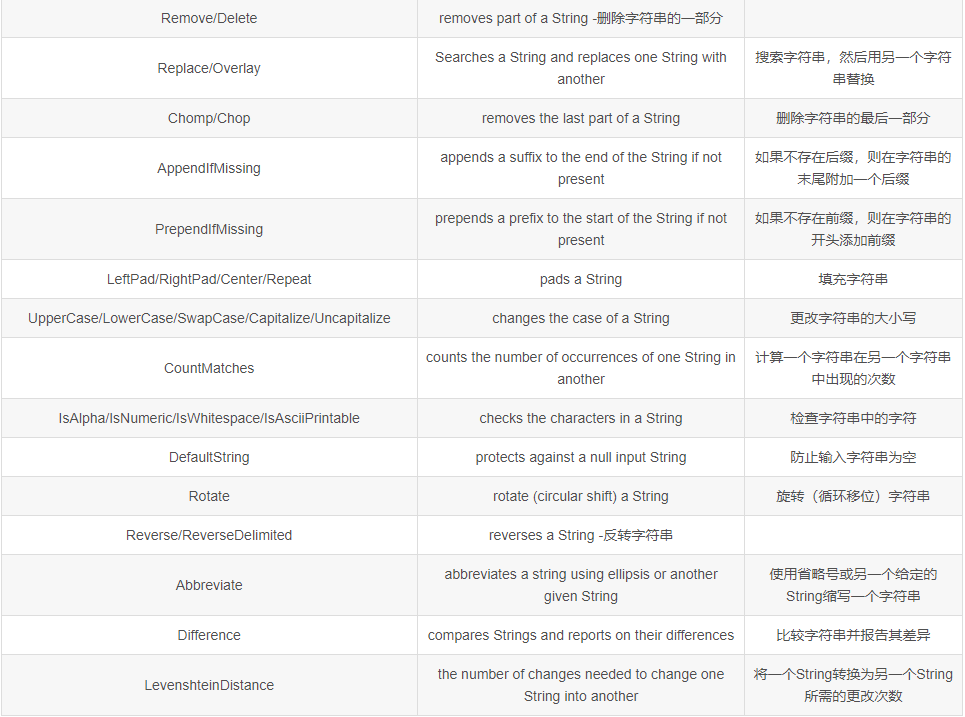isEmpty 和 isBlank 的用法区别,你都知道吗?
StringUtils.isBlank(null) = true
StringUtils.isBlank(“”) = true
StringUtils.isBlank(" ") = true
StringUtils.isBlank(“bob”) = false
StringUtils.isBlank(" bob ") = false
/**
*
Checks if a CharSequence is whitespace, empty (“”) or null.
* @param cs the CharSequence to check, may be null
* @return {@code true} if the CharSequence is null, empty or whitespace
* @since 2.0
* @since 3.0 Changed signature from isBlank(String) to isBlank(CharSequence)
*/
public static boolean isBlank(final CharSequence cs) {
int strLen;
if (cs == null || (strLen = cs.length()) == 0) {
return true;
}
for (int i = 0; i < strLen; i++) {
if (Character.isWhitespace(cs.charAt(i)) == false) {
return false;
}
}
return true;
}
StringUtils.isNotBlank()
Java开源项目【ali1024.coding.net/public/P7/Java/git】
是否真的不为空,不是空格或者空值 ,相当于!isBlank();
public static boolean isNotBlank(final CharSequence cs) {
return !isBlank(cs);
}
StringUtils.isAnyBlank()
是否包含任何真空值(包含空格或空值)
StringUtils.isAnyBlank(null) = true
StringUtils.isAnyBlank(null, “foo”) = true
StringUtils.isAnyBlank(null, null) = true
StringUtils.isAnyBlank(“”, “bar”) = true
StringUtils.isAnyBlank(“bob”, “”) = true
StringUtils.isAnyBlank(" bob ", null) = true
StringUtils.isAnyBlank(" ", “bar”) = true
StringUtils.isAnyBlank(“foo”, “bar”) = false
/**
*
Checks if any one of the CharSequences are blank (“”) or null and not whitespace only…
* @param css the CharSequences 《一线大厂Java面试题解析+后端开发学习笔记+最新架构讲解视频+实战项目源码讲义》开源 to check, may be null or empty
* @return {@code true} if any of the CharSequences are blank or null or whitespace only
* @since 3.2
*/
public static boolean isAnyBlank(final CharSequence… css) {
if (ArrayUtils.isEmpty(css)) {
return true;
}
for (final CharSequence cs : css){
if (isBlank(cs)) {
return true;
}
}
return false;
}
StringUtils.isNoneBlank()
是否全部都不包含空值或空格
StringUtils.isNoneBlank(null) = false
StringUtils.isNoneBlank(null, “foo”) = false
StringUtils.isNoneBlank(null, null) = false
StringUtils.isNoneBlank(“”, “bar”) = false
StringUtils.isNoneBlank(“bob”, “”) = false
StringUtils.isNoneBlank(" bob ", null) = false
StringUtils.isNoneBlank(" ", “bar”) = false
StringUtils.isNoneBlank(“foo”, “bar”) = true
/**
*
Checks if none of the CharSequences are blank (“”) or null and whitespace only…
* @param css the CharSequences to check, may be null or empty
* @return {@code true} if none of the CharSequences are blank or null or whitespace only
* @since 3.2
*/
public static boolean isNoneBlank(final CharSequence… css) {
return !isAnyBlank(css);
}
StringUtils的其他方法
================
可以参考官方的文档,里面有详细的描述,有些方法还是很好用的.
https://commons.apache.org/proper/commons-lang/apidocs/org/apache/commons/lang3/StringUtils.html
(感谢阅读,希望对你所有帮助)
来源:blog.csdn.net/moshowgame/
article/details/102914895
Java网站推荐:www.java1000.com,网站包括Java基础、进阶、源码、面试等各个系列文章,欢迎浏览!
Github仓库推荐:
https://github.com/OUYANGSIHAI/JavaInterview,复制链接直达,该仓库是本人面试一年的面试记录与分享,相信对你有一定的帮助!
推荐文章
1、14个项目!
2、GitHub 上 6 款牛哄哄的后台模板
总结
这个月马上就又要过去了,还在找工作的小伙伴要做好准备了,小编整理了大厂java程序员面试涉及到的绝大部分面试题及答案,希望能帮助到大家
接直达,该仓库是本人面试一年的面试记录与分享,相信对你有一定的帮助!
推荐文章
1、14个项目!
2、GitHub 上 6 款牛哄哄的后台模板
总结
这个月马上就又要过去了,还在找工作的小伙伴要做好准备了,小编整理了大厂java程序员面试涉及到的绝大部分面试题及答案,希望能帮助到大家
[外链图片转存中…(img-DjiLzRZr-1650518084840)]
[外链图片转存中…(img-P7yfrdmD-1650518084841)]



